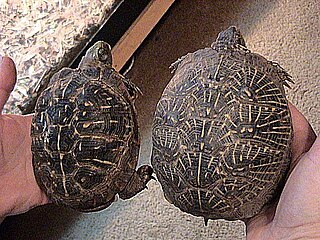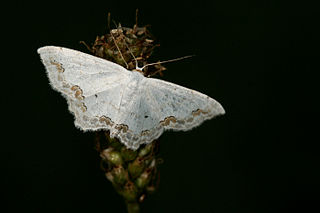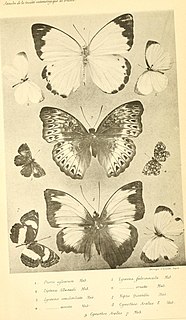Related Research Articles

Smilax ornata is a perennial trailing vine with prickly stems that is native to Mexico and Central America. Common names include sarsaparilla, Honduran sarsaparilla, and Jamaican sarsaparilla. It is known in Spanish as zarzaparrilla, which is derived from the words zarza meaning "bramble", and parrilla, meaning "little grape vine".

The Sri Lanka blue magpie or Ceylon magpie is a brightly coloured member of the Corvidae family and found exclusively in Sri Lanka. This species is adapted to hunting in the dense canopy, where it is highly active and nimble. However, its flight is rather weak and rarely used to cover great distances. In spite of the Sri Lanka blue magpie's ability to adapt to the presence of humans, it is classified as being vulnerable to extinction due to the fragmentation and destruction of its habitat of dense primary forest in the wet zone of Southern Sri Lanka.

Box turtles are North American turtles of the genus Terrapene. Although box turtles are superficially similar to tortoises in terrestrial habits and overall appearance, they are actually members of the American pond turtle family (Emydidae). The twelve taxa which are distinguished in the genus are distributed over four species. They are largely characterized by having a domed shell which is hinged at the bottom, allowing the animal to retract its head and legs and close its shell tightly to protect itself from predators.

Terrapene ornata is a species of North American box turtle sometimes referred to as the western box turtle or ornate box turtle.

The European White Elm cultivar Ulmus laevis 'Ornata' was erroneously identified by Carrière as U. communis ornata in 1858. 'Ornata' was named by Carrière for the numerous and intensely green leaves which gave the trees 'a magnificent appearance'.

Amyda is a genus of softshell turtles in the family Trionychidae. It contains these species:

The ornate box turtle is one of only two terrestrial species of turtles native to the Great Plains of the United States. It is one of the two different subspecies of Terrapene ornata. It is the state reptile of Kansas. It is a relatively small turtle, that is currently listed as threatened in Illinois but is of concern and protected in six Midwestern states. Males and females generally look alike but males are often smaller; there is color variation with yellow lines from the center of the shell to the edges through gray, red-brown, or black coloration. Besides the size, males can be distinguished from females in several ways; a large curved inner claw on the back feet, a cloacal opening that is farther back in males, a longer and thicker tail, and reddish color on the legs and occasionally on the jaw.

Scopula ornata, the lace border, is a moth of the family Geometridae. The species was first described by Giovanni Antonio Scopoli in his 1763 Entomologia Carniolica. It is found in Europe, North Africa and the Near East.

The ornate slider is turtle belonging to the genus Trachemys of the family Emydidae. It is found in Guerrero, Jalisco, Nayarit and Sinaloa in western Mexico.

Oboronia ornata, the untailed ginger white, is a butterfly in the family Lycaenidae. It is found in Guinea, Sierra Leone, Liberia, Ivory Coast, Ghana, Togo, Nigeria, Cameroon, Equatorial Guinea, Gabon, the Republic of the Congo, the Democratic Republic of the Congo, Uganda and Tanzania. The habitat consists of forests and Guinea savanna in riparian vegetation.
Denazinemys was a genus of baenodd turtle that lived in the Late Cretaceous of New Mexico. The holotype specimen, which D. nodosa was based on, USNM 8345, consists of a partial carapace and plastron. It came from the De-na-zin Member of the Kirtland Formation, and therefore, Denazinemys lived in the Kirtlandian land-vertebrate age. Many specimens other than the holotype have been assigned to Denazinemys.
Eunidiini is a tribe of longhorn beetles of the subfamily Lamiinae. It was described by Téocchi et al. in 2010.
Eunidia is a genus of longhorn beetles of the subfamily Lamiinae.
Eunidia fallaciosa is a species of beetle in the family Cerambycidae. It was described by Stephan von Breuning in 1939. It is known from Somalia.
Eunidia annulata is a species of beetle in the family Cerambycidae. It was described by Per Olof Christopher Aurivillius in 1924.
Eunidia brunneopunctata is a species of beetle in the family Cerambycidae. It was described by Per Olof Christopher Aurivillius in 1911. It is known from South Africa, Malawi, Angola, Kenya, Ethiopia, Mozambique, Botswana, Sudan, Namibia, Senegal, the Democratic Republic of the Congo, Tanzania, Somalia, and Uganda.
Eunidia kristenseni is a species of beetle in the family Cerambycidae. It was described by Per Olof Christopher Aurivillius in 1911. It is known from tropical Africa.
Eunidia batesi is a species of beetle in the family Cerambycidae. It was described by Olliff in 1889.
Eunidia strigata is a species of beetle in the family Cerambycidae. It was described by Fahraeus in 1872. It contains the varietas Eunidia strigata var. damarensis.

Metaxina is the only genus in the beetle family Metaxinidae. Its only species is Metaxina ornata.
References
- ↑ BioLib.cz - Eunidia ornata. Retrieved on 8 September 2014.
| This Eunidiini article is a stub. You can help Wikipedia by expanding it. |